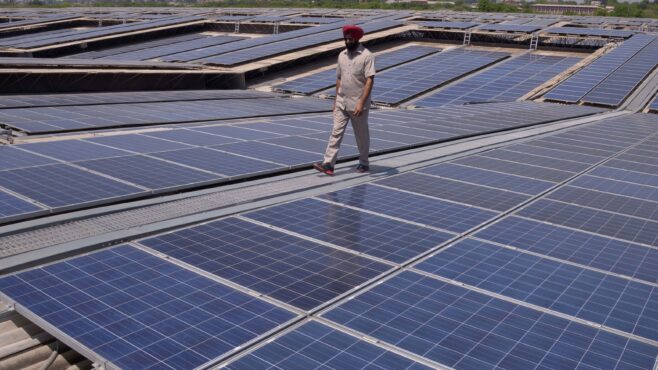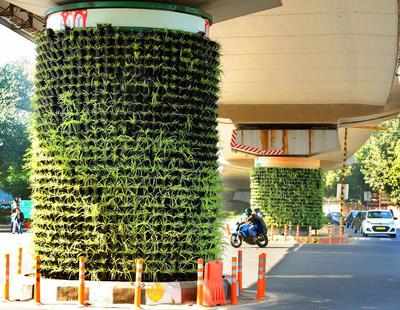
Sky scrapers, highways, bustling metropolitans, speedy commute, concrete marvels rising from the ground, all these make up for a generic imagination of development. In today’s spirited new world innovative and modern infrastructure is a characteristic of a developed nation. But, on the other side of this coin of modernization is a heavy and often invisible price paid by the environment. The ease and support provided by modern development makes it difficult for one to comprehend its darker sides, paving the way to a narrow imagery of development which then gets transformed into reality. From this vantage point, one might feel disillusioned with the idea of modern development, though that is certainly not the intention. The aim is to redefine ‘development’ itself.
An integral part of a nation’s development is its infrastructure. In the present era, it has the power to reshape the human and natural world, for better or worse. In recent years, its impact on environment has been highlighted and though sustainable development remains a goal to be reached, in the increasing sensitivity and concern for cushioning the blows caused by expeditious development lies our key to what has been termed as ‘ecological modernisation’. In order to comprehend the current scenario and future of a positively symbiotic relationship between infrastructure and environment, let us look within – the Indian picture.

India, due to its growing economy and population has been creating demand for infrastructural transformations ever since its independence. According to the report on Infrastructure sector in India infrastructure has been the center of attention of all regimes to the extent that India was predicted to become the third largest construction market globally by 2022.
In paving the way to growth, the Indian government has taken steps to ensure a balance between development and sustainability. The Ministry for New and Renewable Resources works exclusively to facilitate use of greener energy sources. India is an active part of international missions such as the Kyoto Protocol to ensure responsible industrialisation. At the same time, India is one of the largest consumers of coal; majority of rural India relies on traditional ways to meet day to day needs and rampant industrialisation has made all the metro cities’ environment extremely polluted. The bullet train of Indian modernisation seems to be running rapidly, but not towards a sustainable future. Why is that? The dilemma of adopting sustainable development is multi-faceted. First, infrastructure in itself is meant to assist economy and generate financial gain. For a country like India where green infrastructure is not accessible to all due to it being costly, individuals and organisations automatically choose the cheaper and conventional schemes which in most instances aren’t equally beneficial for the environment. Those willing to innovate depend on procuring finances through investors. A green infrastructure at times is not seen by investors as the most profitable option. There is also the problem of periodic change in government and governance pattern. Infrastructure building in India is closely connected with parties’ election manifestos and as the governing party change, so does the government’s vision. The consistency of planning, assessing resources and completing a project is lost in the cycle of elections and politicisation of development. The reluctance of people to switch to innovations has been a barrier in bringing about drastic shifts. There is also a lack of awareness among laypersons and lack of incentives for individuals and organisations working in the direction of research and development. So, what is the solution to these hurdles and what is the future of sustainable infrastructural development in India?

Owing to its geographical location, India has easy access to all renewable resources. The solar potential of India is substantial due to its location between the tropic of Cancer and the Equator. As published in the paper Renewable energy for sustainable development in India: current status, future prospects, challenges, employment, and investment opportunities, we are moving ahead in generating energy from wind and immense potential in terms of using biomass Pre-existing legal, political and social programs are working hard to ensure greater reliance on renewable resources and sustainable development but to optimise their usage a few additional steps can be taken, such as – encouraging combined private-public investment and using the global interest in India to attract impact investing. Push and pull policies together will create the conditions for responsible growth. Not just acquiring funds but using them in the right direction is vital. We need to make funding and selling of new plans and visions transparent, remove corruption from infrastructural development (it is prone to malpractices due to the high gains involved). Green infrastructure (new and sustainable) and grey infrastructure (conventional) can go hand in hand as a complete replacement is not really pragmatic. In 2019 U-Solar Clean Energy Solutions Pvt. Ltd turned a Mumbai data-center into India’s largest building integrated vertical solar system by enveloping the structure in solar panels. There are numerous such examples of organisations thinking past their profits and willingly innovating. At the micro level, we come across news about individuals and smaller groups minimising their consumption of non-biodegradable items, roads being made out of plastic waste and pencils which can be used as seeds!
The present year has been disruptive for the international economy. Industries, development projects and sustainable development goals, all were hit hard by the pandemic. But as the human world came to a standstill, we witnessed the healing of our environment. In the current scheme of things, expeditiously dealing with the economic crisis at any cost seems to be the only good option and the objective of sustainability is slipping away. However, in development or redevelopment, economy, society and environment are all knit together. It has become clearer than ever from the COVID-19 experience that planning ahead is how we can combat upcoming crisis. The focus in rebuilding economy post COVID-19 should be on creating infrastructure which saves resources both economic and natural thus embodying an all-around progress. This ‘new world’ will be full of challenges but also full of possibilities. It is a daunting task to choose sustainable development over a quick fix but as a part of the environment and not its owners, it is our duty. To quote the founder of “Earth Day”, Gaylord Nelson- “The ultimate test of man’s conscience may be his willingness to sacrifice something today for future generations whose words of thanks will not be heard.”

